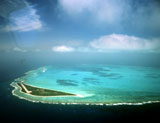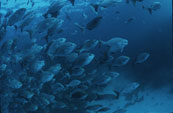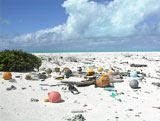|
You
are here: /main/about/kure
atoll
Kure
Atoll

 Kure
Atoll is the most remote of the Northwestern Hawaiian Islands,
and the northern-most coral atoll in the world. Kure is an
oval-shaped atoll, which is 6 miles at its maximum diameter
and 55 miles west-northwest of Midway Atoll at the extreme
northwest end of the Hawaiian archipelago. Green Island is
the only permanent island in the atoll. The island is a nesting
area for shearwaters, petrels, tropicbirds, boobies, frigatebirds,
albatrosses, terns and noddies. It is also a wintering area
for a variety of migratory bird species from North America
and Asia. Kure
Atoll is the most remote of the Northwestern Hawaiian Islands,
and the northern-most coral atoll in the world. Kure is an
oval-shaped atoll, which is 6 miles at its maximum diameter
and 55 miles west-northwest of Midway Atoll at the extreme
northwest end of the Hawaiian archipelago. Green Island is
the only permanent island in the atoll. The island is a nesting
area for shearwaters, petrels, tropicbirds, boobies, frigatebirds,
albatrosses, terns and noddies. It is also a wintering area
for a variety of migratory bird species from North America
and Asia.
Prior
to 1827 Kure Atoll was visited by a half a dozen ships,
and given a new name after each visit. Beginning in 1837,
numerous ships have run aground on the reefs at Kure (previously
known as Cure Island), and crews were stranded on the atoll
for up to nine months at a time, eating monk seals, turtles
and seabirds to survive while they constructed smaller craft
to make the long passage back to the settled Main Hawaiian
Islands. Like many locations in the NWHI, Kure is a low and
inconspicuous feature, only unreliably located by historic
charts of the past, a submerged and often unseen hazard.
Some of Hawaii’s oldest known shipwrecks, such as the
USS Saginaw (1870) and what may be the whaleship Parker (1842)
lie undisturbed at Kure Atoll.
On
September 20, 1886, the ship Waialeale arrived at Kure and
James Boyd took possession of the island in the name of King
Kaläkaua and the Hawaiian Kingdom. The ship's crew built
a shack and left provisions and water tanks for shipwrecked
sailors. In 1894 the island was leased for guano mining, but
no mining was ever done. Kure Atoll was acquired by the United
States of America as part of the Territory of Hawai‘i on July
7, 1898. In 1909, President Theodore Roosevelt made Kure part
of the Hawaiian Islands Bird Reservation, reserving the atoll
for the Department of Agriculture as a preserve for native
birds.
 Despite
its northern location and relatively cool waters, the aquatic
habitats of Kure house a diversity of corals and large invertebrates
such as echinoderms, crustacea and mollusks. Twenty eight
species of stony corals have been documented at Kure and
the
atoll has almost 80,000 acres of coral reef habitat. The
turquoise
waters of the lagoon and near-shore reefs support large schools
of dolphins, jacks, sharks, goatfish, and chub, as well as
dragon morays, knifejaws, masked angelfish and rare native
grouper. Recent aquatic surveys have identified rare fish
species and behaviors seldom seen in the Main Hawaiian Islands,
raising additional questions about the effects of human activities
on marine ecosystems. Despite
its northern location and relatively cool waters, the aquatic
habitats of Kure house a diversity of corals and large invertebrates
such as echinoderms, crustacea and mollusks. Twenty eight
species of stony corals have been documented at Kure and
the
atoll has almost 80,000 acres of coral reef habitat. The
turquoise
waters of the lagoon and near-shore reefs support large schools
of dolphins, jacks, sharks, goatfish, and chub, as well as
dragon morays, knifejaws, masked angelfish and rare native
grouper. Recent aquatic surveys have identified rare fish
species and behaviors seldom seen in the Main Hawaiian Islands,
raising additional questions about the effects of human activities
on marine ecosystems.
Kure
Atoll is an important pupping and resting area for Hawaiian
Monk seals. The Kure Atoll sub-population of monk seals apparently
declined during the 1960s due to increased human disturbance
from the Coast Guard station, but has been increasing in recent
years. The monk seal population size at Kure is currently
about 100-125 animals.
 Other
issues facing the atoll include threats from marine debris.
The atoll lies in the path of a major Pacific current, resulting
in tons of fishing nets and debris washing up on the reefs
and beaches, which pose an entanglement hazard for monk seals,
turtles, seabirds, fish and lobsters. In 2003 alone 2700
pounds of marine debris was removed from Kure, including
997 pounds removed from accumulation study areas that
were cleaned of all marine debris just the year before.
These accumulation study areas, called HERZ or High Entanglement
Risk Zones, are important indicator areas for how quickly
marine debris is accumulating in areas that are known
to be frequented by monk seals. Other
issues facing the atoll include threats from marine debris.
The atoll lies in the path of a major Pacific current, resulting
in tons of fishing nets and debris washing up on the reefs
and beaches, which pose an entanglement hazard for monk seals,
turtles, seabirds, fish and lobsters. In 2003 alone 2700
pounds of marine debris was removed from Kure, including
997 pounds removed from accumulation study areas that
were cleaned of all marine debris just the year before.
These accumulation study areas, called HERZ or High Entanglement
Risk Zones, are important indicator areas for how quickly
marine debris is accumulating in areas that are known
to be frequented by monk seals.
Kure
is the northernmost coral atoll in the world, placing it at
the Darwin Point. Scientists theorize that where coral growth
occurs at a slower rate than the subsidence of the atoll,
the atoll will sink below the surface with no further possibility
of a coral connection. Kure’s coral is still growing
slightly faster than the island is subsiding. Further north
and west, the Emperor Seamounts foretell the future of Kure
and all of the Hawaiian Archipelago. The seamounts lie in
water too deep and cool for coral growth. As Kure Atoll continues
its slow migration atop the Pacific Plate, it too will eventually
slip below the surface.
<<back
-- next>>
 Talk About It! Talk About It!
Kure Atoll Information
Asked by Joe from Designers Associated on Nov 29, 2004.
Hello,
Does anybody live on Kure Island?
From Hawaii, how long does it take to arrive to Kure Island by Boat? or Plane?
Answered by Andy from NOAA on Dec 4, 2004.
Mahalo for your question Joe.
There is no year-round habitation on Green Island, which is the only permanent land on Kure Atoll. The island does have a runway that is not maintained, and a few permanent structures that are the remains of an old Coast Guard LORAN station. These buildings are seasonally occupied by State of Hawaii Department of Land and Natural Resources, Division of Foresty and Wildlife personnel who manage the island as a wildlife refuge. No landings are allowed on the island and all inquiries about the wildlife refuge should be directed to DLNR/DOFAW:
http://www.dofaw.net/
The atoll is roughly 1380 miles from Honolulu, Hawaii.
If you could fly there, which is not currently allowed, it would take about 5 hours on a Gulfstream aircraft.
Most research vessels travel around 10 knots/hour, and 1 knot = 1.1507794 mile/hour. So, travelling by ship, that's about 120 hours, or 5 days from Honolulu. Visiting Kure Atoll
Asked by Ricardo on Dec 1, 2004.
Is it possible to visit or have fieldtrips to Kure Atoll?
Answered by Andy from NOAA on Dec 4, 2004.
Please contact the State of Hawaii, Department of Land and Natural Resources, Divsion of Forestry and Wildlife for more information: (808)587-0166 or http://www.dofaw.net/
The atoll is part of the State of Hawaii and is managed as a Wildlife Refuge to protect several species of seabirds that nest on the atoll, resting and pupping areas for monk seals, and habitat for native plants. Most land areas in the NWHI are extremely sensitive, and can be easily disturbed. Many ground nesting seabirds dig long tunnels in the sandy islands, and walking on the land can easliy collapse these tunnels, crushing young chicks or cutting off their exit. There is also a danger of introduction of alien species of plants and animals. Seeds caught in clothing, or insects stowed away in clothes or equipment can have a dramatic impact if introduced to the islands. Several introduced species have severely damaged native populations of plants and animals, and removal of introduced species is very expensive, labor intensive and complex, sometimes impossible. For these reasons visitation to these islands is either completely restricted or limited to areas of human inhabitation - Tern Island and Midway Atoll.
Please check with DOFAW for the most current information on regulations. Green Island Runway
Asked by Ricardo on Dec 1, 2004.
In pictures it's visible that a runway exists in Green Island(Kure Atoll), was it ever used or its still possible to use it in nowadays?
Answered by Andy from NOAA on Dec 4, 2004.
The Green Island runway is no longer in operation, and aircraft landings are not allowed there. At one time it was in operation when the Coast Guard had a LORAN station on the island. In September 1993 the Coast Guard left Green Island and the runway has been deteriorating ever since. See the question above for more information. Also, there is nice history of the atoll in Mark J. Rauzon's book "Isles of Refuge" What trash is that?
Asked by John on Mar 22, 2006.
With regards to the debris that washes up on the island, I was wondering where most of it came from, and what sorts of things are found in it?
Answered by Paulo from University of Hawaii on Mar 26, 2006.
Marine debris can travel far distances for long time. Trash found on the NWHI can come from anywhere, although the majority of trash that washes ashore comes from commercial fishing in the North Pacific (which tend to be multinationals operations), although there are also some coming from the eastern Pacific ocean. These fishing nets can be of immense size, which are lost in the high seas but brought to the islands by prevailing currents. But these are floating menaces to many forms of marine life, which can become tangled in them. Sea birds are increasingly ingesting large amounts of plastics of small sizes, such as lighters, combs, and anything else. When the birds return to land, these plastics return with them in their stomach, and can then be found by their nests. One more reason to try harder to keep our oceans clean! Rats in Kure
Asked by KEN from NONE on Oct 2, 2006.
I was on Kure for a year back in 1971-1972. It was a beautiful atoll with loads of birds and seals and rats and lots and lots of rats... has the rodent problem fixed itself since the humans and their garbage have left?
Answered by Cynthia Vanderlip on Oct 18, 2006.
The rats were eradicated by DLNR in 1993-1994. We have not seen any evidence of them since. Seabirds species that were wiped out by the rats are starting to return. All ground nesting seabirds that were repressed by the rats are increasing in numbers. now we just need to get rid of the ants and seabird reproductive sucess will probably improve even more. we will bait the ants next year so maybe there are even better days for the Kure seabirds in the near future.
Aloha Kure Human Population
Asked by Russ on Jan 7, 2007.
What a great thing you are doing on this island. How many poeple are living on this island?
Thanks,
Russ
Answered by Paulo Maurin, University of Hawaii on Jan 7, 2007.
Dear Russ,
Thank you for your compliments. There are indeed many worthwhile projects underway at this special atoll.
Kure, as most of the other islands within the NWHI, does not have a permanent human presence. But several islands are home to a handful of researchers during the summer months. In Kure, Cynthia Vanderlip is the main field researcher for the State of Hawaii, and there are other people that work assisting her with bird banding and dolphin studies, as well as a two other people monitoring the monk seals. This brings the total population at Kure to 6 during the research time (but this number can change from year to year, depending on projects and funding available, but it is not normally much higher). The winter months bring difficult ocean conditions, and the human population goes back to zero.
Aloha,
Paulo A Researcher's Hard Work
Asked by Martin from HUMAN RACE on Jul 15, 2007.
I just watched a PBS broadcast that featured the Kure Atoll where Cynthia Vanderlip is a researcher.I don't have a question but I do have a comment.....WOW! What a dedicated scientist Vanderlip is!!! Hats off to her... The world needs more people like her. With deep respect, Martin Montague
Answered by Paulo from the University of Hawaii on Jul 16, 2007.
I agree with you - Cynthia Vanderlip is very dedicated to her work, and Kure atoll has benefited much from her presence there. I had the pleasure of working briefly with her there and came away with the same level of admiration.
Thank you, Martin, for your words of support. Names for Kure Atoll
Asked by Christopher on Dec 8, 2008.
Is Kure also known as Ocean Island?
Answered by Dan from University of Hawaii on Jul 2, 2009.
I have always known the atoll as Kure Atoll and the main island as Green Island, but an online search reveals a number of sources indicating it is also known as Ocean Island, or by its Hawaiian name Mokupāpapa.
|